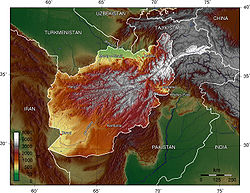
Back جغرافيا أفغانستان Arabic Xeografía d'Afganistán AST Əfqanıstan coğrafiyası Azerbaijani Геаграфія Афганістана Byelorussian География на Афганистан Bulgarian আফগানিস্তানের ভূগোল Bengali/Bangla جوگرافیای ئەفغانستان CKB Geografie Afghánistánu Czech Daearyddiaeth Affganistan Welsh Geografía de Afganistán Spanish
 | |
| Continent | Asia |
|---|---|
| Region | Central Asia / South Asia |
| Coordinates | 33°00′N 65°00′E / 33.000°N 65.000°E |
| Area | Ranked 40th |
| • Total | 652,864 km2 (252,072 sq mi) |
| Coastline | 0 km (0 mi) |
| Borders | Pakistan 2,670 km (1,660 mi), Tajikistan 1,357 km (843 mi), Iran 921 km (572 mi), Turkmenistan 804 km (500 mi), Uzbekistan 144 km (89 mi), China 91 km (57 mi) |
| Highest point | Noshaq, 7,492 m (24,580 ft) |
| Lowest point | Amu Darya at Khamyab, 258 m (846 ft) |
| Longest river | Helmand River |
| Largest lake | Kamal Khan Dam Kajaki Dam Dahla Dam Naghlu Dam Band-e Amir Qargha |
| Climate | Arid to semiarid; cold winters and hot summers |
| Terrain | mostly low plateau with deserts, rangelands and a fertile plain in the southeast |
| Natural resources | natural gas, petroleum, coal, copper, chromite, talc, barites, sulfur, lead, zinc, iron ore, salt, precious and semiprecious stone[1][2][3][4][5] |
| Natural hazards | earthquakes, flooding, avalanches |
| Environmental issues | limited fresh water, soil degradation, overgrazing, deforestation, desertification, air pollution, water pollution |
Afghanistan is a landlocked mountainous country located on the Iranian Plateau,[6] at the crossroads of Central Asia[7][8] and South Asia.[9][10] The country is the 40th largest in the world in size. Kabul is the capital and largest city of Afghanistan, located in the Kabul Province. With a location at the intersection of major trade routes, Afghanistan has attracted a succession of invaders since the sixth century BCE.[11]
Afghanistan contains most of the Hindu Kush. There are a number of major rivers in the country, including Amu Darya, Arghandab, Farah, Hari, Helmand, Kabul, Kokcha, and Kunar. The country also possesses many smaller rivers as well as streams, canals, lakes, ponds, and springs. Most of its fresh water historically flowed into neighboring countries.[12]
- ^ Afghanistan, CIA World Factbook.
- ^ "Gold and copper discovered in Afghanistan" (PDF). bgs.ac.uk. Archived (PDF) from the original on 26 July 2013. Retrieved 5 May 2018.
- ^ "Uranium Mining Issues: 2005 Review". www.wise-uranium.org. Retrieved 5 May 2018.
- ^ Afghanistan's Energy Future and its Potential Implications Archived 2010-06-25 at the Wayback Machine, Eurasianet.org.
- ^ Govt plans to lease out Ainak copper mine, Pajhwok Afghan News.
- ^ Ellington, Lucien (Fall 2012), "Geographical Facts about Afghanistan", Education About Asia, vol. 17, no. 2, Association for Asian Studies
- ^ Starr, Frederick; Cornell, Svante (18 February 2020). "A new strategy for Central Asia". The Hill. Archived from the original on Aug 9, 2023.
, as Afghan President Ashraf Ghani has noted, Afghanistan is itself a Central Asian country.
- ^ Afghanistan. Cambridge University Press. ISBN 9781107619500.
- ^ * "U.S. maps". Pubs.usgs.gov. Archived from the original on 25 December 2013. Retrieved 19 May 2012.
- "South Asia: Data, Projects, and Research". Archived from the original on 1 March 2015. Retrieved 2 March 2015.
- Wandrey, Craig J.; Law, Ben E. "Maps showing geology, oil and gas fields and geological provinces of South Asia". U. S. Geological Survey. Archived from the original on 25 December 2013. Retrieved 2 March 2015.
- "University of Washington Jackson School of International Studies: The South Asia Center". Archived from the original on 2 April 2015. Retrieved 2 March 2015.
- "Syracruse University: The South Asia Center". 26 March 2013. Archived from the original on 26 March 2015. Retrieved 2 March 2015.
- "Center for South Asian studies". Archived from the original on 11 December 2007. Retrieved 2 March 2015.
- ^ "Composition of macro geographical (continental) regions, geographical sub-regions, and selected economic and other groupings". UNdata. 26 April 2011. Archived from the original on 13 July 2011. Retrieved 13 July 2011.
- ^ "Country Profile: Afghanistan" (PDF). United States: Library of Congress Country Studies on Afghanistan. August 2008. Archived from the original (PDF) on April 8, 2014. Retrieved February 11, 2012.
- ^ Cite error: The named reference
Afghanistan and Pakistan's Looming Water Conflictwas invoked but never defined (see the help page).
© MMXXIII Rich X Search. We shall prevail. All rights reserved. Rich X Search